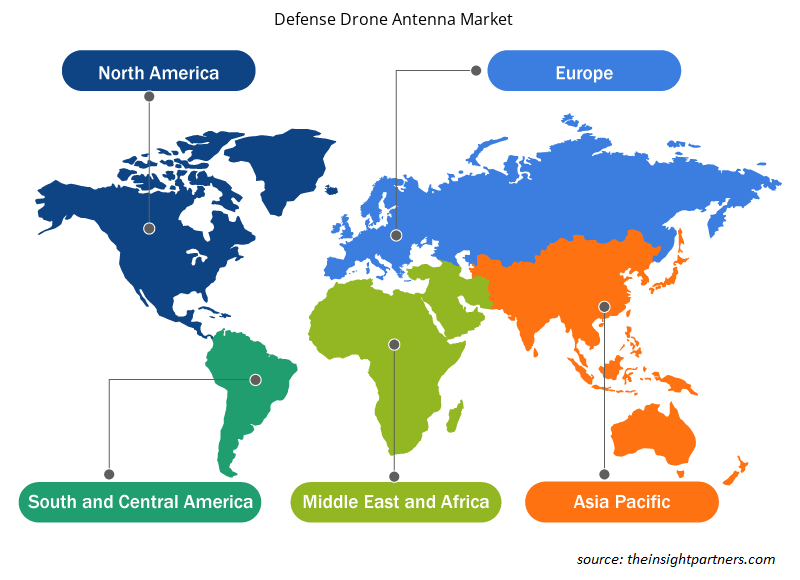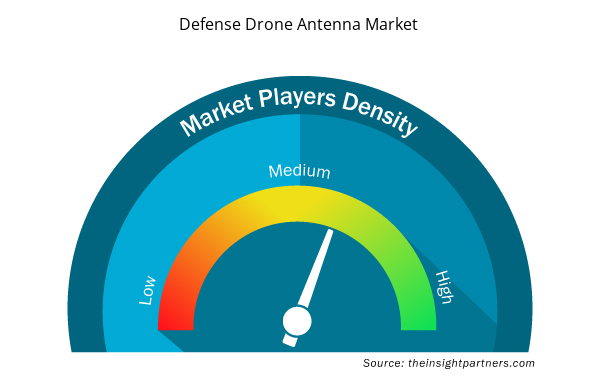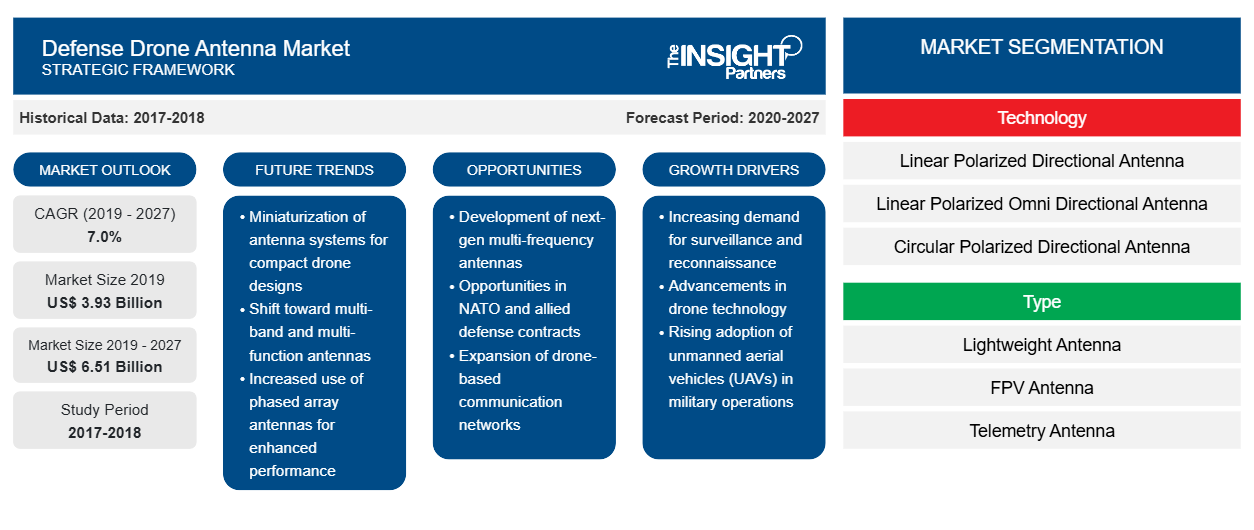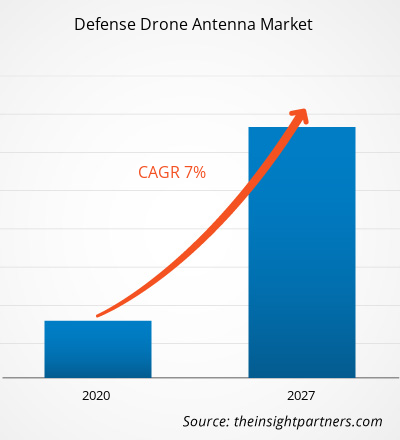In Bezug auf den Umsatz wurde der globale Markt für Antennen für Verteidigungsdrohnen im Jahr 2019 auf 3.925,61 Millionen US-Dollar geschätzt und soll bis 2027 6.505,28 Millionen US-Dollar erreichen; im Prognosezeitraum von 2020 bis 2025 wird mit einer durchschnittlichen jährlichen Wachstumsrate von 7,0 % gerechnet.
Der Markt für Antennen für Verteidigungsdrohnen ist grob in fünf große Regionen unterteilt: Nordamerika, Europa, APAC, MEA und SAM. Nordamerika dominiert den Markt für militärische Drohnen. Daher ist die Nachfrage nach Antennen für Verteidigungsdrohnen aus der Region hoch. Die Akteure und die Regierung in den USA investieren erheblich in Forschung und Entwicklung im Zusammenhang mit militärischen Drohnen. Abgesehen davon würden Kooperationen zwischen Branchenriesen sowie steigende Investitionen in die Entwicklung technologisch fortschrittlicher Drohnen zur Unterstützung vieler militärischer Anwendungen die Nachfrage nach militärischen Drohnen in den USA beschleunigen.
Passen Sie diesen Bericht Ihren Anforderungen an
Sie erhalten kostenlos individuelle Anpassungen an jedem Bericht, einschließlich Teilen dieses Berichts oder einer Analyse auf Länderebene, eines Excel-Datenpakets sowie tolle Angebote und Rabatte für Start-ups und Universitäten.
- Holen Sie sich die wichtigsten Markttrends aus diesem Bericht.Dieses KOSTENLOSE Beispiel umfasst eine Datenanalyse von Markttrends bis hin zu Schätzungen und Prognosen.
Markteinblicke – Markt für Antennen für Verteidigungsdrohnen
Steigendes Interesse an kreisförmigen Rundstrahlantennen
Militärische Kräfte nutzen unbemannte Technologien für Zwecke wie Überwachung, Kommunikation, Navigation und Signalaufklärung (SIGINT). Die Streitkräfte sind ständig auf der Suche nach fortschrittlichen Technologien mit dem Ziel, die Fähigkeiten der unbemannten Fahrzeuge zu verbessern. Die linear polarisierten Rundstrahlantennen gehören zu den bevorzugten Antennentechnologien. Die Vorliebe für zirkular polarisierte Rundstrahlantennen steigt jedoch exponentiell an. Die modernen Militärdrohnen müssen sich ständig bewegen oder manövrieren, um größere Mengen an Informationen zu sammeln; daher müssen sie manchmal akrobatische Flugmanöver durchführen. Die kreisförmigen Antennen sind kleiner, was den zusätzlichen Vorteil einer einfachen Manövrierbarkeit bietet. Neben der kleineren Antennengröße weckt die Fähigkeit, die gesammelten Daten in einem Winkel von 360° zu übertragen, das Interesse der Streitkräfte sowie der Hersteller von Verteidigungsdrohnen. Darüber hinaus verlangen die Streitkräfte eine außergewöhnliche Qualität der erfassten Daten und Bilder, und diese Antennen ermöglichen die Übertragung hochwertiger Bilder während des Drohnenflugs in unmittelbarer Nähe des Ziels. Solche Vorteile kreisförmiger Rundstrahlantennen tragen zum Wachstum des Marktes für Antennen für Verteidigungsdrohnen bei.
Einblicke in das Technologiesegment
Technologisch dominierte das Segment der linear polarisierten Rundstrahlantennen 2019 den globalen Markt für Antennen für Verteidigungsdrohnen. Die linearen Antennen projizieren eine Welle entlang einer einzelnen Ebene, horizontal oder vertikal. Diese Art der Polarisation ermöglicht die Übertragung von mehr Energie, da sich die Welle einfach in eine Richtung bewegt.
Einblicke in das Typsegment
Basierend auf dem Typ dominierte das Segment der Leichtantennen 2019 den globalen Markt für Verteidigungsdrohnenantennen. Kleinere und leichtere UAVs werden in erheblichem Maße für komplexere Geheimdienst- und Kommunikationsanwendungen eingesetzt. Um die Verweilfähigkeit und Ausdauer dieser Fahrzeuge zu erhöhen, besteht ein wachsender Bedarf an leichteren, aerodynamischeren Antennen.
Einblicke in das Frequenzsegment
Basierend auf der Frequenz dominierte das Ultrahochfrequenzsegment 2019 den globalen Markt für Antennen für Verteidigungsdrohnen. Die Ultrahochfrequenzantennen (UHF) arbeiten mit einem Frequenzbereich von über 300 MHz. Im aktuellen Szenario ist UHF das am häufigsten genutzte Frequenzband.
Einblicke in Anwendungssegmente
Branchenbezogen dominierte das Kommunikationssegment 2019 den globalen Markt für Antennen für Verteidigungsdrohnen. Die UAV-Hersteller legen kontinuierlich Wert darauf, hochmoderne Kommunikationssysteme zu integrieren, um dem Militärpersonal an der Basisstation die Kommunikation mit dem UAV zu erleichtern. Um die besten Kommunikationssysteme zu integrieren, ist der Bedarf an Kommunikationsantennen von höchster Bedeutung. Aufgrund der Bedeutung von Kommunikationsantennen für ein UAV wird erwartet, dass die Nachfrage nach Antennen während des gesamten Prognosezeitraums hoch bleiben wird.
Die Marktteilnehmer konzentrieren sich auf Produktinnovationen und -entwicklungen, indem sie fortschrittliche Technologien und Funktionen in ihre Produkte integrieren, um mit der Konkurrenz mithalten zu können.
- Im Jahr 2020 kündigte PPM die Eröffnung von 40 neuen Niederlassungen in Großbritannien an, um seine Aktivitäten in den Bereichen Engineering und Design, Vertrieb und Marketing, Kundenservice sowie Buchhaltung auszubauen.
- Im Jahr 2020 stellte Southwest Antennas zwei neue Rundstrahlantennen für den Einsatz in UHF- und ISM-Bandanwendungen vor. Diese sind ideal für taktische Funksysteme, tragbare Videoempfänger, MIMO- und MANET-Funksysteme, unbemannte Roboterplattformen und andere Anwendungen. Die neuen Antennen sind entweder mit einem Ultra-Flex-Federsockel oder einem flexiblen Schwanenhalssockel erhältlich.
Regionale Einblicke in den Markt für Antennen für Verteidigungsdrohnen
Die regionalen Trends und Faktoren, die den Markt für Antennen für Verteidigungsdrohnen im Prognosezeitraum beeinflussen, wurden von den Analysten von Insight Partners ausführlich erläutert. In diesem Abschnitt werden auch Marktsegmente und Geografien für Antennen für Verteidigungsdrohnen in Nordamerika, Europa, im asiatisch-pazifischen Raum, im Nahen Osten und Afrika sowie in Süd- und Mittelamerika erörtert.

- Erhalten Sie regionale Daten zum Markt für Antennen für Verteidigungsdrohnen
Umfang des Marktberichts zu Antennen für Verteidigungsdrohnen
| Berichtsattribut | Details |
|---|---|
| Marktgröße im Jahr 2019 | 3,93 Milliarden US-Dollar |
| Marktgröße bis 2027 | 6,51 Milliarden US-Dollar |
| Globale CAGR (2019 - 2027) | 7,0 % |
| Historische Daten | 2017-2018 |
| Prognosezeitraum | 2020–2027 |
| Abgedeckte Segmente | Nach Technologie
|
| Abgedeckte Regionen und Länder | Nordamerika
|
| Marktführer und wichtige Unternehmensprofile |
|
Marktteilnehmerdichte: Der Einfluss auf die Geschäftsdynamik
Der Markt für Antennen für Verteidigungsdrohnen wächst rasant, angetrieben durch die steigende Nachfrage der Endnutzer aufgrund von Faktoren wie sich entwickelnden Verbraucherpräferenzen, technologischen Fortschritten und einem größeren Bewusstsein für die Vorteile des Produkts. Mit steigender Nachfrage erweitern Unternehmen ihr Angebot, entwickeln Innovationen, um die Bedürfnisse der Verbraucher zu erfüllen, und nutzen neue Trends, was das Marktwachstum weiter ankurbelt.
Die Marktteilnehmerdichte bezieht sich auf die Verteilung der Firmen oder Unternehmen, die in einem bestimmten Markt oder einer bestimmten Branche tätig sind. Sie gibt an, wie viele Wettbewerber (Marktteilnehmer) in einem bestimmten Marktraum im Verhältnis zu seiner Größe oder seinem gesamten Marktwert präsent sind.
Die wichtigsten auf dem Markt für Antennen für Verteidigungsdrohnen tätigen Unternehmen sind:
- Alaris Holdings Ltd.
- Antcom Corporation
- Antenna Research Associates, Inc.
- Cobham Plc
- JEM-Technik
Haftungsausschluss : Die oben aufgeführten Unternehmen sind nicht in einer bestimmten Reihenfolge aufgeführt.

- Überblick über die wichtigsten Akteure auf dem Markt für Antennen für Verteidigungsdrohnen
Der globale Markt für Antennen für Verteidigungsdrohnen ist wie folgt segmentiert:
Markt für Verteidigungsdrohnenantennen – nach Technologie
- Linear polarisierte Richtantenne
- Linear polarisierte Rundstrahlantenne
- Zirkular polarisierte Richtantenne
- Zirkular polarisierte Rundstrahlantenne
Markt für Verteidigungsdrohnenantennen – nach Typ
- Leichte Antenne
- FPV-Antenne
- Telemetrieantenne
- NLOS-Antenne
- Sonstiges
Markt für Verteidigungsdrohnenantennen – nach Frequenz
- Hochfrequenz
- Sehr hohe Frequenz
- Ultrahochfrequenz
Markt für Verteidigungsdrohnenantennen – nach Anwendung
- Überwachung
- Navigation
- Kommunikation
- Telemetrie
- Sonstiges
Markt für Verteidigungsdrohnenantennen – nach Region
- Nordamerika
- UNS
- Kanada
- Mexiko
- Europa
- Frankreich
- Deutschland
- Italien
- Spanien
- Schweiz
- Vereinigtes Königreich
- Restliches Europa
- Asien-Pazifik (APAC)
- China
- Indien
- Südkorea
- Singapur
- Japan
- Australien
- Restlicher Asien-Pazifik-Raum
- Naher Osten und Afrika (MEA)
- Südafrika
- Saudi-Arabien
- Vereinigte Arabische Emirate
- Rest von MEA
- Südamerika (SAM)
- Brasilien
- Rest von SAM
Markt für Antennen für Verteidigungsdrohnen – Unternehmensprofile
- Alaris Holdings Ltd.
- Antcom Corporation
- Antenna Research Associates, Inc.
- Cobham Plc
- JEM-Technik
- MP Antenna, LTD
- PPM-Systeme
- Southwest Antennas, Inc.
- TE-Konnektivität
- Trimble Inc.
- Historische Analyse (2 Jahre), Basisjahr, Prognose (7 Jahre) mit CAGR
- PEST- und SWOT-Analyse
- Marktgröße Wert/Volumen – Global, Regional, Land
- Branche und Wettbewerbsumfeld
- Excel-Datensatz



Report Coverage
Revenue forecast, Company Analysis, Industry landscape, Growth factors, and Trends

Segment Covered
This text is related
to segments covered.

Regional Scope
North America, Europe, Asia Pacific, Middle East & Africa, South & Central America

Country Scope
This text is related
to country scope.
Häufig gestellte Fragen
The linear polarized omni directional antenna segment led the technology segment. The linear antennas project a wave along a singular plane, horizontal or vertical. This kind of polarization facilitates more energy to be transmitted, as the wave simply moves in one direction. However, penetration of obstacles is reduced pertaining to the difficulty a linear wave faces in navigating around an object that is present in its plane of propagation. On the other hand, omnidirectional antennas are best suitable for the radiation of a signal in all possible directions, but over a comparatively shorter range. The radiation pattern can be clearly captured in the omnidirectional antennas as being particularly well dispersed in all the directions covering the antenna apart from directly below and above the antenna. These antennas are mainly utilized with the video transmitter, as the antennas are well adapted to overcome unexpected changes in the direction and attitude of an aircraft’s flight.
North America is expected to be the largest revenue generator in the defense drone antenna market compared to the other regions. The US Department of Defense (DoD) is anticipated to increase its UAV spending in the next few years to prepare the military for high-end fights against advanced rivals. There was an inclusion of the spending of US$ 3.7 billion on new unmanned systems technology in the president defense budget request for FY 2020. According to the dean of the Mitchell Institute for Aerospace Studies, the US military has enormous opportunities to use UAVs more commonly in various applications, including cargo aircraft and combat aircraft. The growing demand for drones for military application in North America is expected to drive the growth of defense drone antenna market.
A rapidly changing modern warfare has been urging governments of various countries to allocate higher amounts toward the respective military forces. The military budget allocation enables the military forces to procure advanced technologies and equipment from national or international manufacturers. On the same lines, solider and military vehicle modernization practices are also on rise in many countries. The procurement of drones or unmanned aerial vehicles (UAVs) is a major part of this modernization strategy. In addition, the defense ministries worldwide are investing substantial amounts in newer technologies, including contemporary UAVs or unmanned aircraft systems (UAS). Surge in orders for the drones or UAVs or UASs from the defense forces signifies a substantial demand for drone antennas, which is driving the defense drone antenna market.
Trends and growth analysis reports related to Aerospace and Defense : READ MORE..
The List of Companies - Defense Drone Antenna Market
- Alaris Holdings Ltd.
- Antcom Corporation
- Antenna Research Associates, Inc.
- Cobham Plc
- JEM Engineering
- MP Antenna, LTD
- PPM Systems
- Southwest Antennas, Inc.
- TE Connectivity
- Trimble Inc.
The Insight Partners performs research in 4 major stages: Data Collection & Secondary Research, Primary Research, Data Analysis and Data Triangulation & Final Review.
- Data Collection and Secondary Research:
As a market research and consulting firm operating from a decade, we have published and advised several client across the globe. First step for any study will start with an assessment of currently available data and insights from existing reports. Further, historical and current market information is collected from Investor Presentations, Annual Reports, SEC Filings, etc., and other information related to company’s performance and market positioning are gathered from Paid Databases (Factiva, Hoovers, and Reuters) and various other publications available in public domain.
Several associations trade associates, technical forums, institutes, societies and organization are accessed to gain technical as well as market related insights through their publications such as research papers, blogs and press releases related to the studies are referred to get cues about the market. Further, white papers, journals, magazines, and other news articles published in last 3 years are scrutinized and analyzed to understand the current market trends.
- Primary Research:
The primarily interview analysis comprise of data obtained from industry participants interview and answers to survey questions gathered by in-house primary team.
For primary research, interviews are conducted with industry experts/CEOs/Marketing Managers/VPs/Subject Matter Experts from both demand and supply side to get a 360-degree view of the market. The primary team conducts several interviews based on the complexity of the markets to understand the various market trends and dynamics which makes research more credible and precise.
A typical research interview fulfils the following functions:
- Provides first-hand information on the market size, market trends, growth trends, competitive landscape, and outlook
- Validates and strengthens in-house secondary research findings
- Develops the analysis team’s expertise and market understanding
Primary research involves email interactions and telephone interviews for each market, category, segment, and sub-segment across geographies. The participants who typically take part in such a process include, but are not limited to:
- Industry participants: VPs, business development managers, market intelligence managers and national sales managers
- Outside experts: Valuation experts, research analysts and key opinion leaders specializing in the electronics and semiconductor industry.
Below is the breakup of our primary respondents by company, designation, and region:

Once we receive the confirmation from primary research sources or primary respondents, we finalize the base year market estimation and forecast the data as per the macroeconomic and microeconomic factors assessed during data collection.
- Data Analysis:
Once data is validated through both secondary as well as primary respondents, we finalize the market estimations by hypothesis formulation and factor analysis at regional and country level.
- Macro-Economic Factor Analysis:
We analyse macroeconomic indicators such the gross domestic product (GDP), increase in the demand for goods and services across industries, technological advancement, regional economic growth, governmental policies, the influence of COVID-19, PEST analysis, and other aspects. This analysis aids in setting benchmarks for various nations/regions and approximating market splits. Additionally, the general trend of the aforementioned components aid in determining the market's development possibilities.
- Country Level Data:
Various factors that are especially aligned to the country are taken into account to determine the market size for a certain area and country, including the presence of vendors, such as headquarters and offices, the country's GDP, demand patterns, and industry growth. To comprehend the market dynamics for the nation, a number of growth variables, inhibitors, application areas, and current market trends are researched. The aforementioned elements aid in determining the country's overall market's growth potential.
- Company Profile:
The “Table of Contents” is formulated by listing and analyzing more than 25 - 30 companies operating in the market ecosystem across geographies. However, we profile only 10 companies as a standard practice in our syndicate reports. These 10 companies comprise leading, emerging, and regional players. Nonetheless, our analysis is not restricted to the 10 listed companies, we also analyze other companies present in the market to develop a holistic view and understand the prevailing trends. The “Company Profiles” section in the report covers key facts, business description, products & services, financial information, SWOT analysis, and key developments. The financial information presented is extracted from the annual reports and official documents of the publicly listed companies. Upon collecting the information for the sections of respective companies, we verify them via various primary sources and then compile the data in respective company profiles. The company level information helps us in deriving the base number as well as in forecasting the market size.
- Developing Base Number:
Aggregation of sales statistics (2020-2022) and macro-economic factor, and other secondary and primary research insights are utilized to arrive at base number and related market shares for 2022. The data gaps are identified in this step and relevant market data is analyzed, collected from paid primary interviews or databases. On finalizing the base year market size, forecasts are developed on the basis of macro-economic, industry and market growth factors and company level analysis.
- Data Triangulation and Final Review:
The market findings and base year market size calculations are validated from supply as well as demand side. Demand side validations are based on macro-economic factor analysis and benchmarks for respective regions and countries. In case of supply side validations, revenues of major companies are estimated (in case not available) based on industry benchmark, approximate number of employees, product portfolio, and primary interviews revenues are gathered. Further revenue from target product/service segment is assessed to avoid overshooting of market statistics. In case of heavy deviations between supply and demand side values, all thes steps are repeated to achieve synchronization.
We follow an iterative model, wherein we share our research findings with Subject Matter Experts (SME’s) and Key Opinion Leaders (KOLs) until consensus view of the market is not formulated – this model negates any drastic deviation in the opinions of experts. Only validated and universally acceptable research findings are quoted in our reports.
We have important check points that we use to validate our research findings – which we call – data triangulation, where we validate the information, we generate from secondary sources with primary interviews and then we re-validate with our internal data bases and Subject matter experts. This comprehensive model enables us to deliver high quality, reliable data in shortest possible time.


 Holen Sie sich ein kostenloses Muster für diesen Bericht
Holen Sie sich ein kostenloses Muster für diesen Bericht